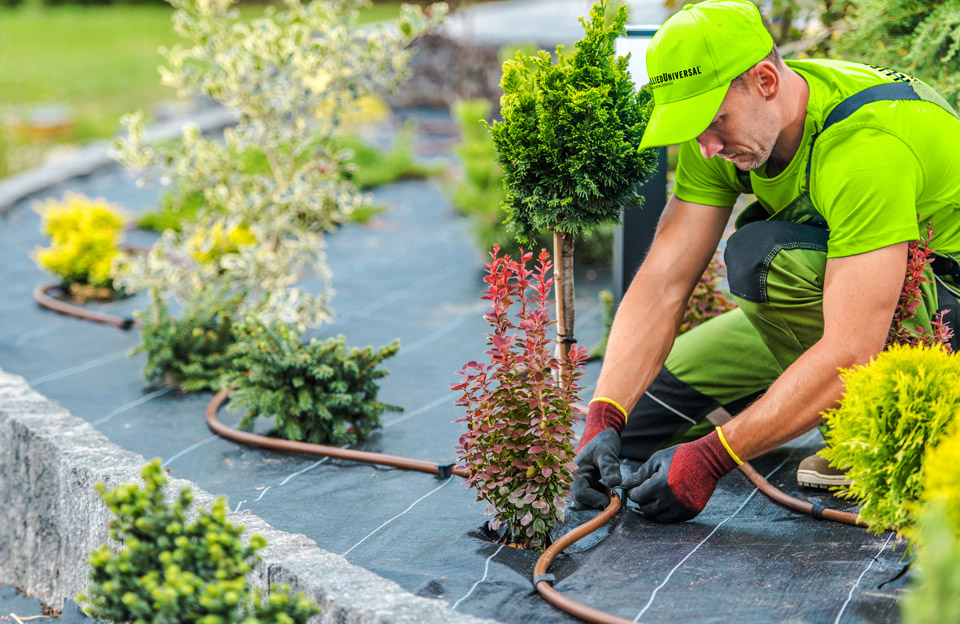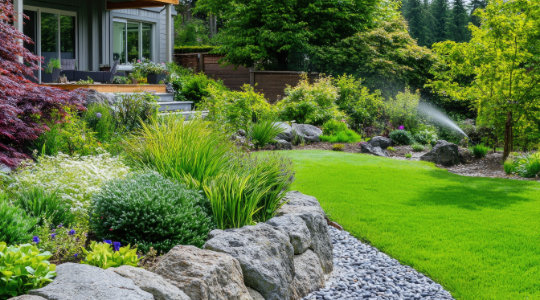Ways to design a stunning landscaping plan for your backyard
Understanding the Comprehensive Extent of Works in Specialist Landscaping Services
The substantial range of expert landscaping services encompasses a range of fundamental elements - landscaping services. It consists of landscape style principles, plant selection, and hardscaping features. Additionally, it deals with watering systems and upkeep methods. Each element plays an important role in creating useful and visually pleasing outside spaces. Recognizing exactly how these elements collaborate can disclose much regarding the art and scientific research of landscape design. The trip into this detailed field is just beginning.
Landscape Layout Concepts
Effective landscape layout principles are essential for producing harmonious exterior areas that boost both aesthetic allure and performance (Learn More). These principles direct the arrangement of aspects within the landscape, making certain a natural visual experience. Secret elements consist of equilibrium, which disperses aesthetic weight evenly; proportion, which associates the size of different components to each other and the area; and unity, which produces a feeling of integrity via regular motifs and materials

Plant Selection and Setup
In the domain name of specialist landscape design, plant choice and installment play an essential role in attaining a growing yard. Stressing indigenous plant advantages, seasonal factors to consider, and the details soil and sunshine requirements of each varieties guarantees a lasting and cosmetically pleasing landscape. Cautious preparation in these areas not just boosts biodiversity yet additionally promotes long-term eco-friendly health and wellness.
Native Plant Advantages
Why should home owners think about indigenous plants for their landscaping tasks? Native plants supply countless benefits that boost both aesthetic appeals and environmental sustainability. They are well-adapted to local environments, calling for less water and maintenance compared to non-native types. This resilience lowers the requirement for chemical fertilizers and pesticides, advertising a healthier community. Additionally, native plants supply habitat and food for regional wildlife, including pollinators, which can raise biodiversity in residential areas. Their experience with neighborhood soil and climate condition additionally leads to better development prices and long life. By selecting native plants, house owners not just develop visually enticing landscapes but also add to environmental preservation, making a favorable effect on their local environment. As a result, indigenous plants stand for a wise selection for landscape design tasks.
Seasonal Plant Considerations
Homeowners who have embraced native plants in their landscaping can further boost their outdoor spaces by considering seasonal plant options. By incorporating plants that grow in details periods, they can develop dynamic and visually attractive landscapes throughout the year. Springtime might usher in dynamic blossoms like tulips and daffodils, while summer season can display rich foliage and vivid perennials. Fall presents a palette of warm tones with goldenrods and asters, while wintertime can be highlighted with evergreens and ornamental grasses for appearance. Professional landscapers commonly advise picking plants that not only complement existing indigenous types but also give year-round rate of interest and assistance regional wildlife. This thoughtful strategy to seasonal plant choice guarantees a continually advancing and sustainable garden atmosphere.
Soil and Sunshine Needs
Effective landscaping pivots on comprehending the particular dirt and sunshine needs of plants. Different types flourish under differing conditions, calling for a cautious assessment of both aspects during the selection procedure. Dirt types, such as sandy, clay, or fertile, impact drainage, vitamins and mineral availability, and origin development. In addition, pH levels can impact plant health, requiring soil screening to determine viability. Sunlight demands differ considerably; some plants prosper completely sunlight, while others like partial or complete color. A specialist landscaper takes into consideration these elements to ensure peak growth and visual appeal. By lining up plant selections with the environment's particular features, landscapes can achieve sustainability, durability, and visual consistency, inevitably leading to successful plant facility and lasting upkeep.
Hardscaping Features and Construction

While landscape design commonly stimulates photos of rich greenery and dynamic flowers, hardscaping features play a vital duty in specifying outside rooms. These aspects, which include patios, pathways, preserving wall surfaces, and ornamental stonework, supply structure and performance to gardens and backyards. Hardscaping utilizes products such as concrete, block, stone, and timber, enabling diverse styles that match the natural landscape.
The building and construction of hardscaping functions requires mindful preparation and execution to assure toughness and aesthetic appeal. Professionals analyze site problems, drain, and spatial relationships to develop natural outside environments. Correct installation strategies are important, as they prevent concerns like erosion and moving over time.
Including hardscaping not only boosts the visual rate of interest of a home yet likewise promotes outdoor tasks, making it a fundamental element of thorough landscape design services. Inevitably, thoughtful hardscaping contributes to both the capability and beauty of outside rooms.
Irrigation Solutions and Water Management
Efficient watering systems and water monitoring are important parts of specialist landscape design, as they guarantee that plants get the essential hydration for perfect growth. These systems can differ from straightforward drip irrigation configurations to advanced computerized automatic sprinkler, developed to satisfy the details needs of diverse landscapes. Proper water administration not just maximizes water use, reducing waste, but likewise improves plant health and wellness and lessens condition threats.
Landscape design specialists assess various elements, including soil type, plant types, and regional climate, to establish tailored irrigation services. Furthermore, integrating rainwater harvesting techniques can even more enhance sustainability and efficiency. Regular upkeep of watering systems is necessary to maintain functionality and prevent leakages, which can bring about water loss and raised prices (Learn More). Eventually, a well-designed watering system plays a pivotal duty in protecting the visual charm of exterior areas while advertising environmental stewardship within professional landscape design practices
Yard Care and Upkeep Strategies
Yard treatment and maintenance approaches are essential for attaining a rich, healthy and balanced yard that boosts the overall landscape. These techniques include various techniques focused on promoting ideal growth and visual appeal. Routine mowing click this is crucial, as it encourages thick, also development while preventing weeds from developing. Furthermore, appropriate fertilizing provides needed nutrients, with applications tailored to the particular lawn kind and soil conditions.
Watering methods need to focus on deep, occasional watering to encourage root advancement, while aeration enhances dirt framework and promotes nutrient absorption. Insect and condition monitoring is also important; determining concerns early permits effective treatments that reduce damage.
Lastly, overseeding can invigorate slim or broken grass, boosting thickness and shade. By applying these targeted grass treatment techniques, landscaping experts can ensure that lawns remain healthy and lively throughout the periods, substantially adding to the general appeal of the building
Seasonal Landscape Treatment and Maintenance
As the seasons change, proper landscape treatment comes to be crucial for preserving the health and wellness and charm of outdoor rooms. Each period provides unique challenges and requirements. In springtime, landscape experts focus on trimming, growing, and fertilizing to encourage development. Summer demands normal watering, weed control, and bug administration to safeguard freshly developed plants.

Throughout the year, seasonal landscape maintenance assurances that outside areas stay healthy and balanced and visually enticing. Expert services can provide tailored upkeep strategies that adapt to the specific demands of each season, permitting homeowner to take pleasure in vivid landscapes year-round. In general, seasonal care is an essential aspect of expert landscape design that advertises durability and visual worth.

Sustainable Landscaping Practices
A growing number of residential property proprietors are welcoming lasting landscape design techniques to develop environmentally friendly outdoor spaces. These practices focus on conserving resources, enhancing biodiversity, and minimizing environmental impact. Native plants are often chosen for their low water needs and compatibility with neighborhood ecosystems, reducing the demand for chemical plant foods and chemicals. Rain gardens and permeable paving are used to take care of stormwater overflow, advertising groundwater recharge and decreasing erosion.
Sustainable landscape design integrates organic horticulture methods that prioritize dirt health and promote natural parasite control. Effective irrigation systems, such as drip watering and rainwater harvesting, help maximize water use. Additionally, landscape developers increasingly advocate for making use of recycled materials, such as redeemed wood and stones, to lessen waste. By embracing these sustainable techniques, homeowner not just add to ecological conservation but additionally create cosmetically pleasing atmospheres that can love very little upkeep.
Often Asked Questions
How much time Does a Landscaping Task Normally Take to Total?
Typically, a landscape design task can take anywhere from a few days to a number of weeks to complete, depending upon the task's complexity, dimension, and design demands. Variables such as weather and resource accessibility also influence timelines.
What Aspects Impact the Cost of Landscaping Services?
Different aspects affect landscape design solution expenses, consisting of job size, design complexity, material quality, labor expenses, geographical area, and seasonal demand. Each element adds distinctly to the general financial requirements of a landscape design task.
Are Landscaping Services Available Year-Round?
Landscape design services are usually readily available year-round, although schedule might vary based upon area, seasonal weather, and particular solution offerings. Some services could be restricted during extreme climate or off-peak periods.
Do Landscape Design Business Offer Service Warranties on Their Job?
Numerous landscaping firms do use guarantees on their work, which can differ in length and coverage. Clients are urged to ask about specific terms, guaranteeing they comprehend what is guaranteed and any kind of problems that use.
Can I Style My Landscape Without Professional Aid?
Yes, individuals can design their landscapes without expert help. They may do not have knowledge in plant option, layout, and ecological considerations, possibly leading to much less effective layouts that could need pricey modifications later on.
In the domain of specialist landscaping, plant choice and installment play an important role in accomplishing a growing garden. Property owners that have accepted indigenous plants in their landscape design can even more improve their exterior spaces by thinking about seasonal plant options. Effective landscaping pivots on recognizing the specific soil and sunshine demands of plants. Effective irrigation systems and water administration are crucial parts of professional landscaping, as they ensure that plants obtain the necessary hydration for optimal development. Landscape design specialists assess various elements, including soil type, plant types, and neighborhood environment, to create customized watering remedies.